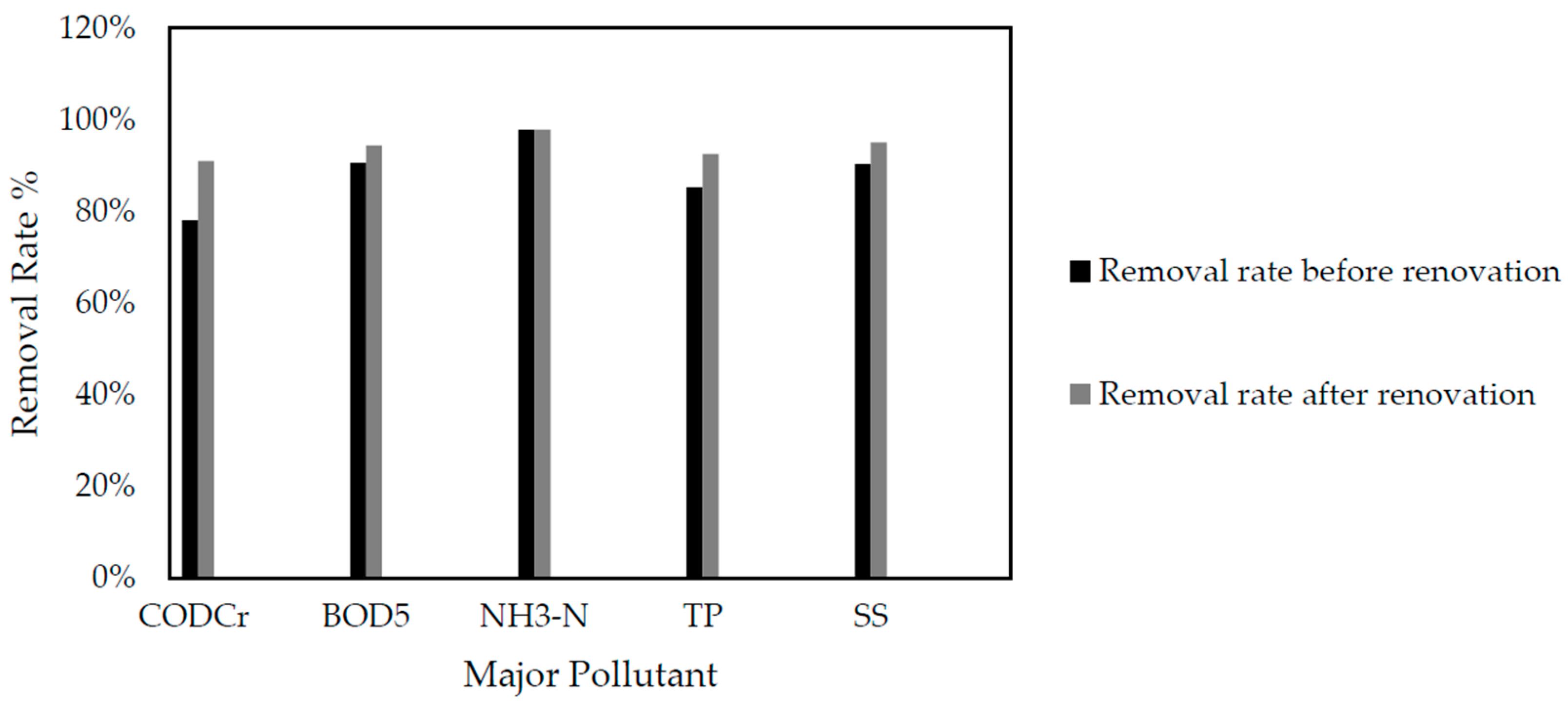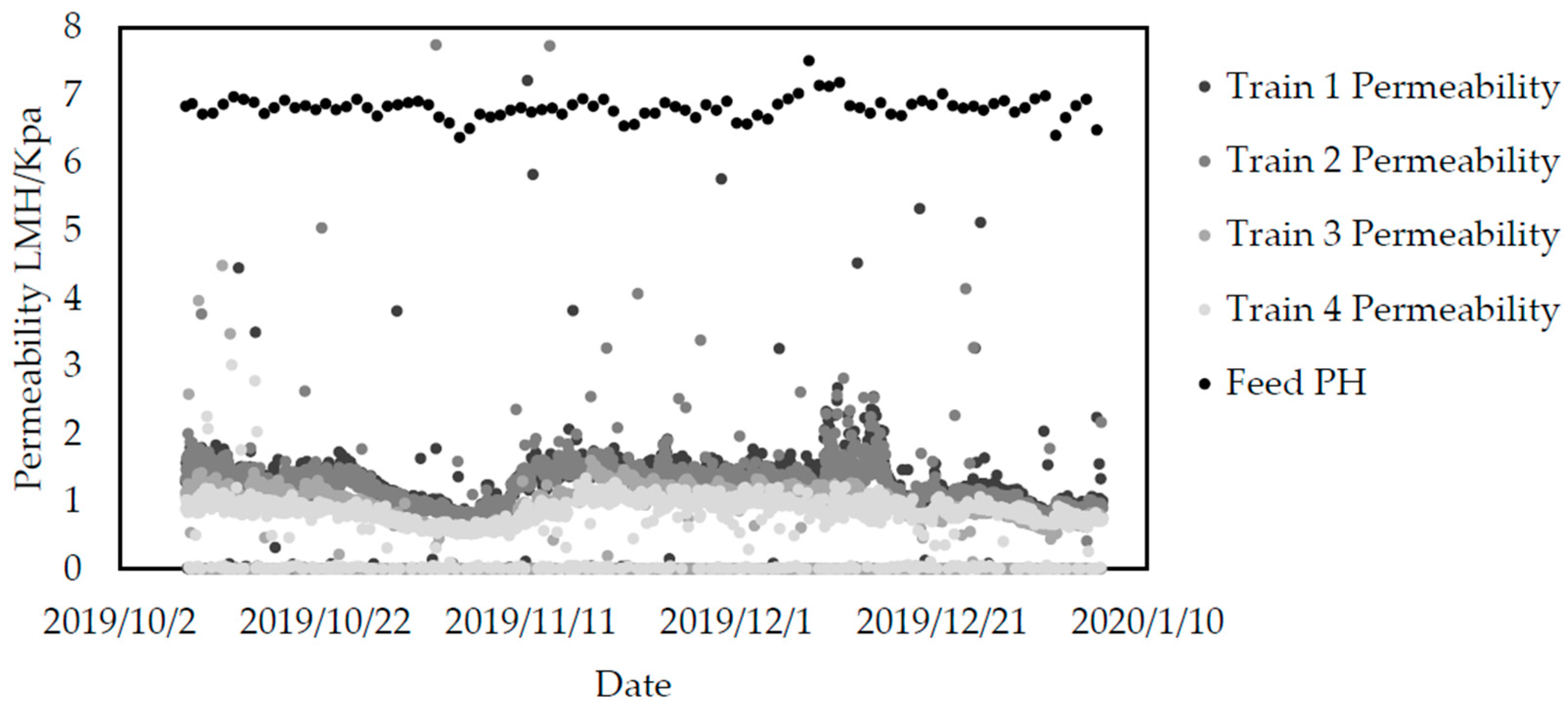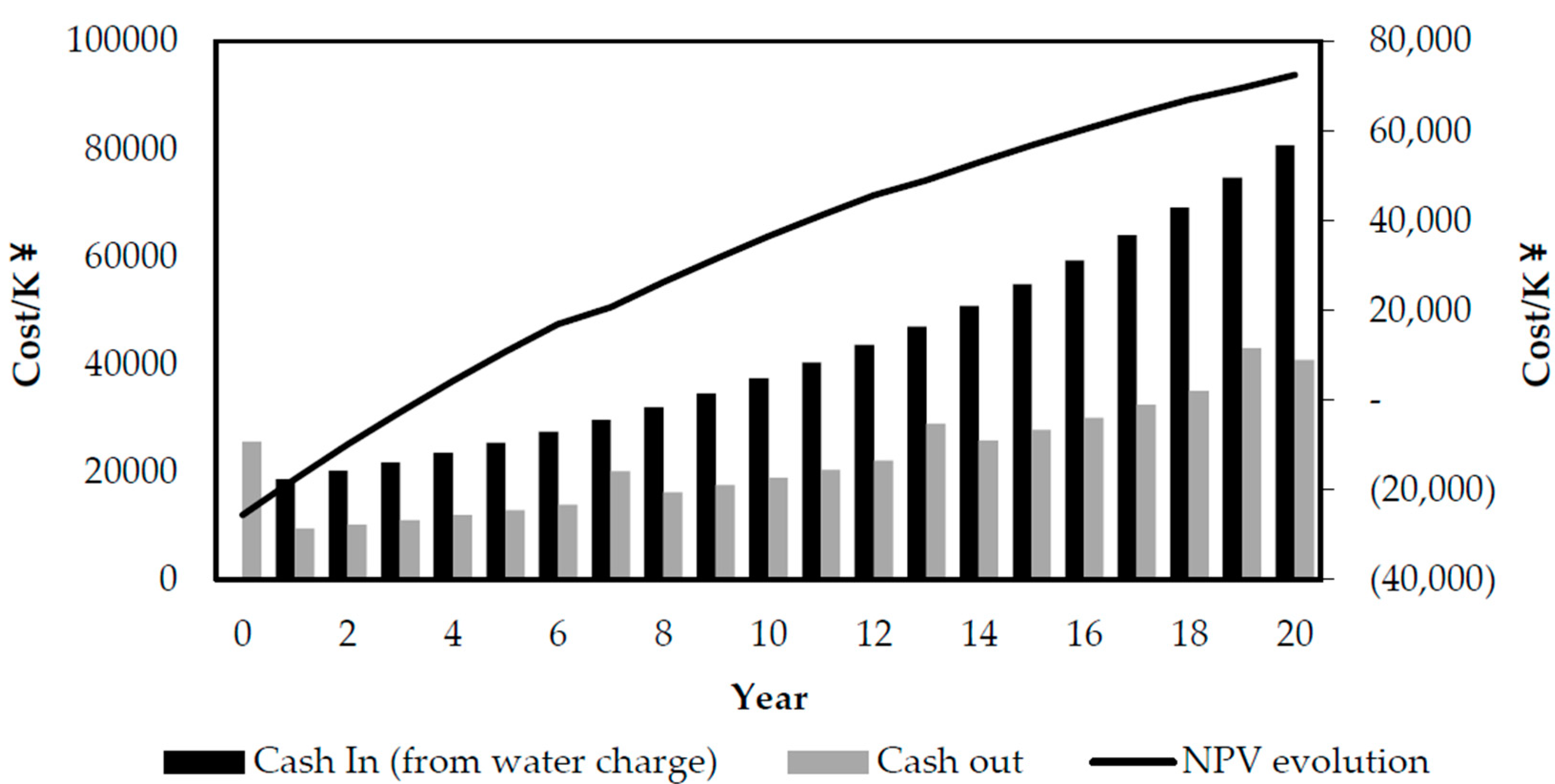Technical and Economic Evaluation of WWTP Renovation Based on Applying Ultrafiltration Membrane
Abstract
:1. Introduction
2. Background
2.1. Plant Current Condition
2.2. Selection of Renovation Methodologies
2.3. Implementation of Renovation
2.3.1. Upgrading of A/A/O Treatment Process
2.3.2. Upgrading of Phosphorus Removal System
2.3.3. Addition of Ultrafiltration Membrane
3. Evaluation Method
3.1. Technical Analysis
3.2. Economical Analysis
4. Results and Discussion
4.1. Technical Results
4.2. Economical Results
4.3. Challenges and Future Research Orientations
5. Conclusions
Author Contributions
Funding
Conflicts of Interest
References
- Chen, B.; Wang, M.; Duan, M. In search of key: Protecting human health and the ecosystem from water pollution in China. J. Clean. Prod. 2019, 228, 101–111. [Google Scholar] [CrossRef]
- Wang, Q.; Yang, Z. Industrial water pollution, water environment treatment, and health risks in China. Environ. Pollut. 2016, 218, 358–365. [Google Scholar] [CrossRef] [PubMed]
- Chakraborti, L.; Mcconnell, K.E. Does ambient water quality affect the stringency of regulations? Plant–level evidence of the clean water art. Land Econ. 2012, 88, 518–535. [Google Scholar] [CrossRef]
- Effluent Limitations Guidelines and Standards for the Construction and Development Point Source Category [DB/OL]; United States Environmental Protection Agency: Washington, DC, USA, 2013.
- Wang, X.-H.; Wang, X.; Huppes, G.; Heijungs, R.; Ren, N.-Q. Environmental implications of increasingly stringent sewage discharge standards in municipal wastewater treatment plants: Case study of a cool area of China. J. Clean. Prod. 2015, 94, 278–283. [Google Scholar] [CrossRef]
- Zhang, Q.H.; Yang, W.N.; Ngo, H.H.; Guo, W.S. Current status of urban wastewater treatment plants in China. Environ. Int. 2016, 92–93, 11–22. [Google Scholar] [CrossRef]
- Collivignarelli, M.C.; Abbà, A.; Bertanza, G.; Frattarola, A. The upgrading of conventional activated sludge processes with thermophilic aerobic membrane reactor: Alternative solutions for sludge reduction. J. Environ. Manag. 2020, 264, 110490. [Google Scholar] [CrossRef]
- Tang, Y.H.; Lin, Y.K.; Zhou, B.; Wang, X.L. PVDF membranes prepared via thermally induced (liquidliquid) phase separation and their application in municipal sewage and industry wastewater for water recycling. Desalin. Water Treat. 2016, 57, 22258–22276. [Google Scholar] [CrossRef]
- Acero, J.L.; Benitez, F.J.; Leal, A.I.; Real, F.J.; Teva, F. Membrane filtration technologies applied to municipal secondary effluents for potential reuse. J. Hazard. Mater. 2010, 177, 390–398. [Google Scholar] [CrossRef]
- Al Aani, S.; Mustafa, T.N.; Hilal, N. Ultrafiltration membranes for wastewater and water process engineering: A comprehensive statistical review over the past decade. J. Water Process Eng. 2020, 35, 101241. [Google Scholar] [CrossRef]
- Diaz, S.D.; Peña, L.V.; Cabrera, E.G. Effect of previous coagulation in direct ultrafiltration of primary settled municipal wastewater. Desalination 2012, 204, 41–48. [Google Scholar] [CrossRef]
- Kajenthira, A.; Siddiqi, A.; Anadon, L.D. A new case for promoting wastewater reuse in Saudi Arabia: Bringing energy into the water equation. J. Environ. Manag. 2012, 102, 184–192. [Google Scholar] [CrossRef] [PubMed]
- Xu, Y.; Tang, Q.; Li, D.; Zhou, X.; Sun, G.; Wang, J.; Wang, J. Demonstration project of upgrading reconstruction using ultra-filtration membrane process in Zhaoqing New & High-Tech Zone Waterworks. Water Technol. 2012, 6, 44–47. [Google Scholar]
- Huang, Y.; Feng, X. Polymer-enhanced ultrafiltration: Fundamentals, applications and recent developments. J. Membr. Sci. 2019, 586, 53–83. [Google Scholar] [CrossRef]
- Kirschner, A.Y.; Cheng, Y.-H.; Paul, D.R.; Field, R.W.; Freeman, B.D. Fouling mechanisms in constant flux crossflow ultrafiltration. J. Membr. Sci. 2019, 574, 65–75. [Google Scholar] [CrossRef] [Green Version]
- Fuchs, W.; Theiss, M.; Braun, R. Influence of standard wastewater parameters and pre-flocculation on the fouling capacity during dead end membrane filtration of wastewater treatment effluents. Sep. Purif. Technol. 2006, 52, 46–52. [Google Scholar] [CrossRef]
- Xiong, R.; Yu, X.; Yu, L.; Peng, Z. Biological denitrification using polycaprolactone-peanut shell as slow-release carbon source treating drainage of municipal WWTP. Chemosphere 2019, 235, 434–439. [Google Scholar] [CrossRef]
- Ren, J.; Li, N.; Wei, H.; Li, A.; Yang, H. Efficient removal of phosphorus from turbid water using chemical sedimentation by FeCl3 in conjunction with a starch-based flocculant. Water Res. 2020, 170, 115361. [Google Scholar] [CrossRef]
- Mbamba, C.K.; Lindblom, E.; Flores-Alsina, X.; Tait, S. Plant-wide model-based analysis of iron dosage strategies for chemical phosphorus removal in wastewater treatment systems. Water Res. 2019, 155, 12–25. [Google Scholar]
- Tang, Y.; Lin, Y.; Lin, H.; Li, C.; Zhou, B.; Wang, X. Effects of Room Temperature Stretching and Annealing on the Crystallization Behavior and Performance of Polyvinylidene Fluoride Hollow Fiber Membranes. Membranes 2020, 10, 38. [Google Scholar] [CrossRef] [Green Version]
- Li, D.; Krantz, W.B.; Greenberg, A.R.; Sani, R.L. Membrane formation via thermally induced phase separation (TIPS): Model development and validation. J. Membr. Sci. 2006, 279, 50–60. [Google Scholar] [CrossRef]
- Aziz, M.; Ojumu, T. Exclusion of Estrogenic and Androgenic Steroid Hormones from Municipal Membrane Bioreactor Wastewater Using UF/NF/RO Membranes for Water Reuse Application. Membranes 2020, 10, 37. [Google Scholar] [CrossRef] [PubMed] [Green Version]
- Ambre, H.P.; Saner, A.B.; Aher, P.D. Comparison of Life Cycle Cost Analysis for Water Treatment Plant by Net Present Value method and Equivalent Annual Cost Method. Int. J. Mod. Trends Eng. Res. 2016, 3, 421–425. [Google Scholar]
- Leyman, P.; Van Driessche, N.; Vanhoucke, M.; De Causmaecker, P. The impact of solution representations on heuristic net present value optimization in discrete time/cost trade-off project scheduling with multiple cash flow and payment models. Comput. Oper. Res. 2019, 103, 184–197. [Google Scholar] [CrossRef]
- Xing, C.-H.; Tardieu, E.; Qian, Y.; Wen, X.-H. Ultrafiltration membrane bioreactor for urban wastewater reclamation. J. Membr. Sci. 2000, 177, 73–82. [Google Scholar] [CrossRef]
- Fan, J.; Hu, H.; Zhang, Y.; Zhu, L. Biological Phosphorus Removal Combined with Ferrous Chemical Phosphorus Removal. Adv. Mater. Res. 2014, 955–959, 3339–3342. [Google Scholar] [CrossRef]
- Wu, Y.; Zhang, Z.; He, P.; Ren, H.; Wei, N.; Zhang, F.; Cheng, H.; Wang, Q. Membrane fouling in a hybrid process of enhanced coagulation at high coagulant dosage and cross-flow ultrafiltration for deinking wastewater tertiary treatment. J. Clean. Prod. 2019, 230, 1027–1035. [Google Scholar] [CrossRef]
- Ao, L.; Liu, W.; Zhang, M.; Wang, X. Analysis of effect of particles on cake layer compressibility during ultrafiltration of upflow biological activated carbon effluent. Sci. Total Environ. 2018, 619, 232–238. [Google Scholar] [CrossRef]
- Dogan, E.C.; Yasar, A.; Sen, U.; Aydiner, C. Water recovery from treated urban wastewater by ultrafiltration and reverse osmosis for landscape irrigation. Urban Water J. 2016, 13, 553–568. [Google Scholar] [CrossRef]
- Maurer, M. Specific net present value an improved method for assessing modularisation costs in water services with growing demand. Water Res. 2009, 43, 2121–2130. [Google Scholar] [CrossRef]
- Ahmad, T.; Guria, C.; Mandal, A. A review of oily wastewater treatment using ultrafiltration membrane: A parametric study to enhance the membrane performance. J. Water Process Eng. 2020, 36, 101289. [Google Scholar] [CrossRef]
- Falsanisi, D.; Liberti, L.; Notarnicola, M. Ultrafiltration (UF) Pilot Plant for Municipal Wastewater Reuse in Agriculture: Impact of the Operation Mode on Process Performance. Water 2010, 2, 872–885. [Google Scholar] [CrossRef] [Green Version]
- Huang, H.; Lee, N.; Young, T.; Gary, A.; Lozier, J.C.; Jacangelo, J.G. Natural organic matter fouling of low-pressure, hollow-fiber membranes: Effects of NOM source and hydrodynamic conditions. Water Res. 2007, 41, 3823–3832. [Google Scholar] [CrossRef] [PubMed]
- Howe, K.J.; Clark, M.M. Fouling of microfiltration and ultrafiltration membranes by natural waters. Environ. Sci. Technol. 2002, 36, 3571–3576. [Google Scholar] [CrossRef] [PubMed]
- Yin, N.; Zhong, Z.; Xing, W. Ceramic membrane fouling and cleaning in ultrafiltration of desulfurization wastewater. Desalination 2013, 319, 92–98. [Google Scholar] [CrossRef]
- Bourgeous, K.N.; Darby, J.L.; Tchobanoglous, G. Ultrafiltration of wastewater: Effects of particles, mode of operation, and backwash effectiveness. Water Res. 2001, 35, 77–90. [Google Scholar] [CrossRef]
- Cabassud, C.; Laborie, S.; Lainé, J.M. How slug flow can enhance the ultrafiltration flux in organic hollow fibres. J. Memb. Sci. 1997, 128, 93–101. [Google Scholar] [CrossRef]
- Benito, A.; Garcia, G.; Gonzalez-Olmos, R. Fouling reduction by UV-based pretreatment in hollow fiber ultrafiltration membranes for urban wastewater reuse. J. Membr. Sci. 2017, 536, 141–147. [Google Scholar] [CrossRef]
- Wang, Z.; Fan, Z.; Xie, L.; Wang, S. Study of integrated membrane system for the treatment of wastewater from cooling towers. Desalination 2006, 191, 117–124. [Google Scholar] [CrossRef]
- Huttinger, A.; Dreibelbis, R.; Roha, K.; Ngabo, F.; Kayigamba, F.; Mfura, L.; Moe, C. Evaluation of Membrane Ultrafiltration and Residual Chlorination as a Decentralized Water Treatment Strategy for Ten Rural Healthcare Facilities in Rwanda. Int. J. Environ. Res. Public Health. 2015, 12, 13602–13623. [Google Scholar] [CrossRef] [Green Version]
- Ren, H.-J.; Lin, W.-Z.; Gao, L.-X.; Shi, C.-L.; Kong, X.-J. Discussion on Evalution System of Ultrafiltration Membrane System for Municipal Sewege Treatment. China Water Wastewater 2016, 32, 30–33. [Google Scholar]






| Nr. | Items | Primary-Level | |
|---|---|---|---|
| A-Class | B-Class | ||
| 1 | Chemical oxygen demand (CODCr) | 50 mg/L | 60 mg/L |
| 2 | Biochemical oxygen demand (BOD5) | 10 mg/L | 20 mg/L |
| 3 | Suspended solids (SS) | 10 mg/L | 20 mg/L |
| 4 | Animal and plant oil | 1 mg/L | 3 mg/L |
| 5 | Petroleum | 1 mg/L | 3 mg/L |
| 6 | Anionic surfactant | 0.5 mg/L | 1 mg/L |
| 7 | Total nitrogen (in N) | 15 mg/L | 20 mg/L |
| 8 | Ammonia nitrogen (in N) | 5 (8) mg/L | 8 (15) mg/L |
| 9 | Total phosphorus (in P) | 0.5 mg/L | 1 mg/L |
| 10 | Chroma (dilution) | 30 mg/L | 30 mg/L |
| 11 | pH | 6–9 | 6–9 |
| 12 | Number of fecal coliforms (1/L) | 103 | 104 |
| Nr. | Items | Class I | Class II | Class III | Class IV | Class V |
|---|---|---|---|---|---|---|
| 1 | Temperature °C | Weekly mean maximum temperature rise ≤ 1 Weekly mean maximum temperature drop ≤ 2 | ||||
| 2 | pH | 6–9 | ||||
| 3 | Dissolved oxygen (DO) ≥ mg/L | 7.5 | 6 | 5 | 3 | 2 |
| 4 | Chemical oxygen demand (CODCr) mg/L | 15 | 15 | 20 | 30 | 40 |
| 5 | Biochemical oxygen demand (BOD5) mg/L | 3 | 3 | 4 | 6 | 10 |
| 6 | Total nitrogen (in N) (TN) mg/L | 0.2 | 0.5 | 1.0 | 1.5 | 2.0 |
| 7 | Ammonia nitrogen (in N) (NH3–N) mg/L | 0.15 | 0.5 | 1.0 | 1.5 | 2.0 |
| 8 | Total phosphorus (in P) (TP) mg/L | 0.02 | 0.1 | 0.2 | 0.3 | 0.4 |
| Months | 1 | 2 | 3 | 4 | 5 | 6 | 7 | Average | |
|---|---|---|---|---|---|---|---|---|---|
| CODCr (mg/L) | Influent | 202 | 180 | 237 | 166 | 142 | 142 | 138 | 78% |
| Effluent | 41 | 47 | 38 | 30 | 28 | 35 | 40 | ||
| Removal rate | 80% | 74% | 84% | 82% | 80% | 75% | 71% | ||
| BOD5 (mg/L) | Influent | 67.2 | 61.6 | 78.4 | 52.5 | 56.8 | 45.2 | 59.4 | 91% |
| Effluent | 5.9 | 6.4 | 5.6 | 5.1 | 5 | 4.8 | 6.2 | ||
| Removal rate | 91% | 90% | 93% | 90% | 91% | 89% | 90% | ||
| NH3–N (mg/L) | Influent | 15.97 | 14.87 | 16.47 | 15.42 | 17.01 | 16.14 | 14.1 | 98% |
| Effluent | 0.25 | 1.21 | 0.22 | 0.15 | 0.26 | 0.17 | 0.14 | ||
| Removal rate | 98% | 92% | 99% | 99% | 98% | 99% | 99% | ||
| TP (mg/L) | Influent | 3.24 | 3.3 | 2.71 | 2.46 | 2.45 | 2.43 | 2.85 | 85% |
| Effluent | 0.64 | 0.74 | 0.13 | 0.19 | 0.35 | 0.34 | 0.58 | ||
| Removal rate | 80% | 78% | 95% | 92% | 86% | 86% | 80% | ||
| SS (mg/L) | Influent | 102 | 105 | 146 | 113 | 93 | 117 | 97 | 90% |
| Effluent | 10 | 10 | 11 | 9 | 9 | 13 | 12 | ||
| Removal rate | 90% | 90% | 92% | 92% | 90% | 89% | 88% | ||
| Items | Parameters |
|---|---|
| Model | SMT600-P80 |
| Material | PVDF |
| Pore size (μm) | 0.1 |
| Membrane area (m2) | 80 |
| Nominal size (mm) | Φ225 * 2360 |
| Resistance to NaClO (ppm) | 5000 |
| Months | 10 | 11 | 12 | Average | Standard | |
|---|---|---|---|---|---|---|
| CODCr (mg/L) | Influent | 171 | 202 | 164 | 91% | 30 mg/L |
| Effluent | 18 | 17 | 15 | |||
| Removal rate | 89% | 92% | 91% | |||
| NH3–N (mg/L) | Influent | 20.3 | 28.19 | 27 | 99.8% | 1.5 mg/L |
| Effluent | 0.05 | 0.05 | 0.07 | |||
| Removal rate | 99.7% | 99.8% | 99.7% | |||
| TP (mg/L) | Influent | 2.31 | 3.24 | 2.42 | 93% | 0.3 mg/L |
| Effluent | 0.17 | 0.16 | 0.16 | |||
| Removal rate | 93% | 95% | 93% | |||
| SS (mg/L) | Influent | 72 | 95 | 83 | 98% | 5 mg/L |
| Effluent | 1.65 | 1.43 | 1.84 | |||
| Removal rate | 98% | 98% | 98% | |||
| Nr. | Chemical Agents | Dosage Quantity (kg/d) |
|---|---|---|
| 1 | Sodium hypochlorite | 76 |
| 2 | Sodium hydroxide | 14.6 |
| 3 | Hydrochloric acid | 12.78 |
| 4 | Phosphorus removal agent | 6075.4 |
| 5 | Sodium acetate | 8000 |
| Evaluation Item | Weight | |
|---|---|---|
| Renovation methodologies | Effluent quality | ++++ |
| Automaticity | ++ | |
| Security | ++ | |
| Installation convenience | ++ | |
| Floor space | + | |
| Construction difficulty | ++ | |
| Stability | ++ | |
| Ultrafiltration membrane | Chemical tolerance | +++ |
| Material safety | ++ | |
| Warranty period | +++ | |
| Cleaning period | + | |
| Fouling resistant | ++ | |
| Integrity | +++ | |
| Environmental adaptability | + | |
| Evaluation Item | Weight | |
|---|---|---|
| Total investment costs | Including equipment, materials, construction, installation | +++ |
| Operating costs | Including power consumption costs, chemical consumption, costs, labor costs and management fees | +++ |
| Sewage treatment fee | +++ | |
© 2020 by the authors. Licensee MDPI, Basel, Switzerland. This article is an open access article distributed under the terms and conditions of the Creative Commons Attribution (CC BY) license (http://creativecommons.org/licenses/by/4.0/).
Share and Cite
Bai, H.; Lin, Y.; Qu, H.; Zhang, J.; Zheng, X.; Tang, Y. Technical and Economic Evaluation of WWTP Renovation Based on Applying Ultrafiltration Membrane. Membranes 2020, 10, 180. https://doi.org/10.3390/membranes10080180
Bai H, Lin Y, Qu H, Zhang J, Zheng X, Tang Y. Technical and Economic Evaluation of WWTP Renovation Based on Applying Ultrafiltration Membrane. Membranes. 2020; 10(8):180. https://doi.org/10.3390/membranes10080180
Chicago/Turabian StyleBai, He, Yakai Lin, Hongbin Qu, Jinglong Zhang, Xiaohong Zheng, and Yuanhui Tang. 2020. "Technical and Economic Evaluation of WWTP Renovation Based on Applying Ultrafiltration Membrane" Membranes 10, no. 8: 180. https://doi.org/10.3390/membranes10080180
APA StyleBai, H., Lin, Y., Qu, H., Zhang, J., Zheng, X., & Tang, Y. (2020). Technical and Economic Evaluation of WWTP Renovation Based on Applying Ultrafiltration Membrane. Membranes, 10(8), 180. https://doi.org/10.3390/membranes10080180





